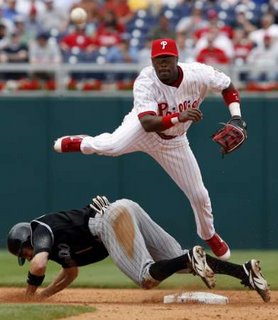Thursday, May 25, 2006
Is Citizens helping the Phillies defense?

This is an idea that I’ve been chewing on for a little while and I want to share my thoughts with everyone else …
According to most of the systems that I’ve looked at the Phillies were pretty much the best defensive team in the major leagues in 2005. The Phillies were fifth in the MLB in Defense Efficiency Ratio (DER*), and first in John Dewan’s Plus / Minus system. (This year they seem to be struggling a little.) Since they’ve moved to Citizens it seems like the Phillies have been pretty good fielders, better than when they played at the Vet. Is Citizens helping the Phillies play defense?
* DER – Defense Efficiency Ratio: (Batters Faced – (Hits + Walks + Hit By Pitch + Strikeouts)) / (Batters Faced – (Home Runs, Walks + Hit By Pitch + Strikeouts)) How often fielders convert balls put into play into outs.
I suppose you have to look at this from a few angles:
-The infield. In every park it is 90 feet to first, 90 feet to second, etc. Unlike the contours of the outfield, the infield is a constant. Also, because nearly every team plays on natural grass these days there are very little grass vs. artificial turf issues in play. Oh sure, I bet that some teams probably keep the grass long to slow down the ball or pull other tricks. (e.g., the Giants watering the field at old Candlestick to slow down the Dodgers speedster Maury Wills in the 1962 Dodgers – Giants pennant race.)
There is little we can objectively consider here. According to The Fielding Bible, the Phillies excelled in infield defense in 2005: allowing far fewer hits than the rest of the league (e.g., the Phillies allowed 99 hits through the hole in between third base and shortstop, compared with 115 on average, 147 up the middle as opposed to 177, etc.). I don’t think there is a park factor here: the Phillies are good defensively in the infield.
-The outfield. Here I am certain the contours of the field pose an issue. After all, if has to be rough being a leftfielder in Boston with the Green Monster behind you. (Still no excuse for your lousy play, Manny!) It must also be easier to play in the outfield in a little park. E.g., if it is 400 feet to straight center, then an outfielder must defend 310 feet worth of territory. If it is 350 feet, then 260 feet to defend. Those fifty feet are probably twelve or so strides and the difference between catching a low fly and missing it.
Citizens is a pretty comfy park, generally speaking. The lack of distance in the outfield must be a huge plus for the Phillies outfielders.
Let’s compare the right-field power alley at Citizens and PNC Park in Pittsburgh.
Citizens: 369 feet
PNC: 375 feet
There is an added factor here: PNC Park sits on the banks of the Allegheny River just north of the confluence where the Allegheny combines with the Monongahela to form the Ohio River. There is a lot of moisture in the air thanks to the river, which probably makes hitting the ball deep harder.
How did the Phillies do defensively with the shorter power-alley and less humid air? The Phils allowed 125 hits in the gap, far fewer than the MLB average of 144. The Pirates allowed 176 hits in the gap.
Okay, maybe this isn’t the best example. I did stack the deck a little by looking for a variance. And Bobby Abreu is a better fielder than Matt Lawton, though not by much: Abreu had a -13 Plus / Minus in 2005, compared to Lawton’s -17. Still, can you really deny that Citizens doesn’t play a factor in why the Phillies were 41 hits better than the Pirates? I submit that the short fence helped Bobby Abreu get to more balls because tough catches simply sailed out of the field of play and became home runs.
Something to chew on for a few days. I’m taking a looooong weekend, so see everyone next Tuesday or Wednesday.
Comments:
Counter-intuitive though it is, humid air is actually less dense than dry air. Robert Adair duscusses this in his book The Physics of Baseball.
You would also need to compare the centerfielders between the 2 clubs. The better the centerfielder the more space the right and left fielders can stay closer to the lines.
harrahs80: I'm curious why you think that a small field hurts the D.
Sabertj: Good point about the CFs. Hmmm....
John: thanks for the info. That is counterintuitive, but I'm fascinated. I'll have to get that book pronto.
I'd like to see some more comments and thoughts on the subject. There is a lot of chew on and I'm curious about the factors in play here.
Post a Comment
Sabertj: Good point about the CFs. Hmmm....
John: thanks for the info. That is counterintuitive, but I'm fascinated. I'll have to get that book pronto.
I'd like to see some more comments and thoughts on the subject. There is a lot of chew on and I'm curious about the factors in play here.












